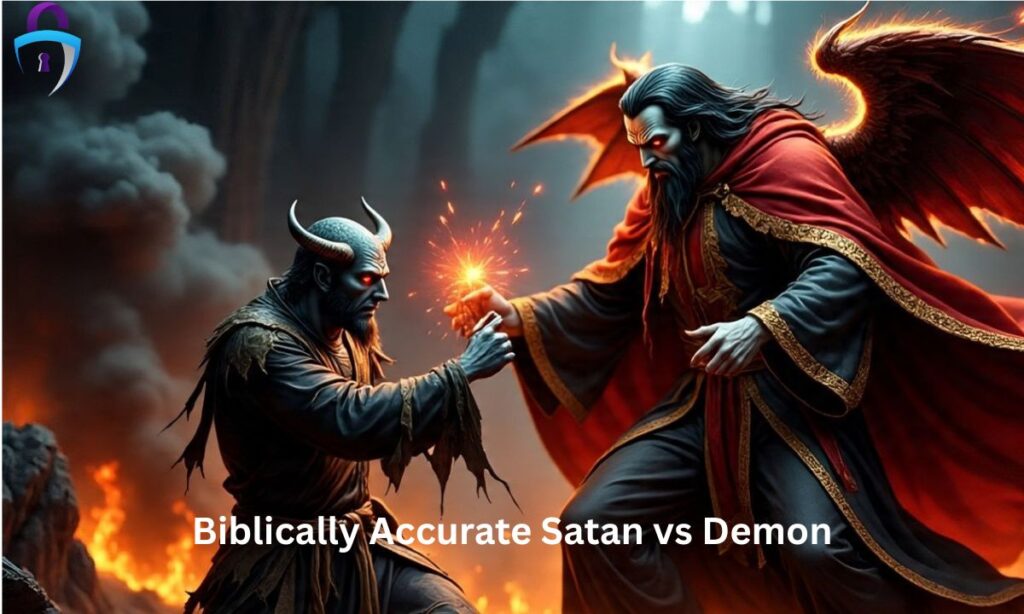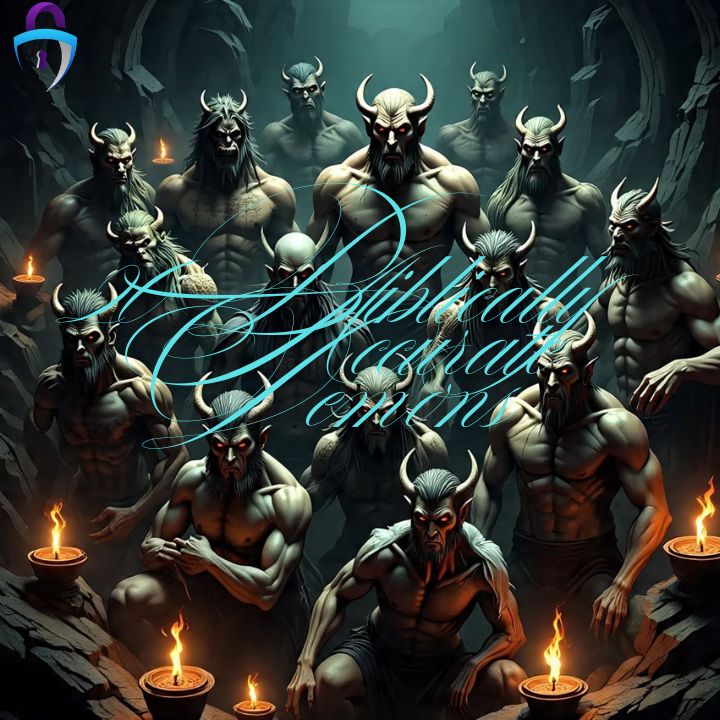Demons are real spiritual beings mentioned throughout the Bible. Satan leads all demons as their prince and commander. The Bible describes different types of demons with specific powers and purposes.
Jesus cast out many demons during His ministry on earth. Christians have authority over demons through Jesus Christ’s name and power. God is always more powerful than any demon or evil spirit.
What is Demonology?
Demonology represents the systematic theological study of demons, evil spirits, and supernatural entities within Christian doctrine. The term derives from the Greek word “daimon,” which originally described any divine or spiritual being, not exclusively malevolent entities.
However, Christian theology transformed this concept, establishing clear distinctions between holy angels and fallen spiritual beings. Biblical demonology developed through careful examination of scriptural references, extrabiblical sources, and centuries of theological scholarship.
8 Types of Demons
1. Fallen Angels
The most widely accepted theological position identifies demons as angels who rebelled against God’s authority. Matthew 25:41 describes “eternal fire prepared for the devil and his angels,” suggesting that angelic rebellion resulted in divine punishment. Revelation 12:4 indicates Satan took one-third of heaven’s angels with him during his fall from the divine realm.
2. Territorial Spirits
Daniel 10:13 reveals the “Prince of Persia,” a demonic entity that opposed God’s messenger for twenty-one days until Archangel Michael intervened. These territorial demons appear to have influence over specific geographic regions, nations, or cultural groups, engaging in cosmic spiritual warfare against divine purposes.
3. Unclean Spirits
Throughout the New Testament, Jesus encountered various “unclean spirits” causing physical ailments, mental torment, and moral corruption. These entities represent spiritual contamination that separates individuals from God and community, often manifesting through illness, compulsive behaviors, or psychological distress.
4. Spirits of Divination
Acts 16:16-18 describes a slave girl possessed by “a spirit of divination” (Python spirit in Greek) who followed Paul and Silas. This demon enabled fortune-telling and brought profit to her masters, illustrating how demonic forces can appear beneficial while ultimately being spiritually destructive.
5. Familiar Spirits
Old Testament passages warn against consulting familiar spirits or mediums who claim communication with the dead. These demonic entities masquerade as deceased individuals to deceive people into occult practices forbidden by biblical law.
6. Seducing Spirits
1 Timothy 4:1 warns of “seducing spirits and doctrines of demons” that lead people away from biblical truth through false teachings. These entities specialize in spiritual deception, promoting heretical doctrines and corrupting pure Christian faith.
7. Spirits of Infirmity
Luke 13:11-16 describes a woman bound by “a spirit of infirmity” for eighteen years, causing physical disability. These demons specialize in causing chronic illness, disabilities, and physical suffering as manifestations of spiritual oppression.
8. Destroying Spirits
Biblical accounts include angels of destruction who execute divine judgment, such as the destroyer in Exodus 12:23 and the angel who slaughtered 185,000 Assyrians in 2 Kings 19:35. While operating under God’s authority, these beings demonstrate the fearsome power of spiritual forces.
Demonology: A Brief Biblical and Historical Background
Christian demonology evolved gradually through centuries of biblical study and theological exploration. Early church fathers carefully examined scriptural references to understand spiritual beings and their roles in divine warfare, combining canonical Bible teachings with historical references from ancient manuscripts.
Jewish teachings significantly influenced early Christian doctrine about evil spirits. Hebrew scriptures provided foundational understanding of spiritual warfare, while Greek New Testament writings offered clearer definitions for apostolic communities. This theological development helped establish consistent Christian beliefs about demonic beings and their opposition to God’s authority.
Extrabiblical sources like the Book of Enoch provided additional context for understanding angelic hierarchies and fallen angels. These non-canonical texts influenced Christian theology without contradicting scriptural accuracy, helping scholars fill gaps in biblical narratives about supernatural beings while maintaining biblical authority.
The medieval period saw extensive development of demonological systems, with theologians like Thomas Aquinas providing systematic approaches to understanding evil spirits. However, the Reformation emphasized returning to biblical sources rather than elaborate philosophical constructions about demonic hierarchies.
What Does The Devil Look Like?
Satan’s appearance has evolved dramatically throughout art history, influenced more by cultural interpretations than scriptural accuracy. Biblical texts provide limited physical descriptions of the adversary, focusing instead on his spiritual nature, character, and destructive influence on humanity.
Ancient Hebrew texts associate Satan with the serpent in Genesis, though the scriptures don’t explicitly identify the Eden tempter as Satan. Early Christian interpretations connected these references based on Revelation 12:9 describing “that ancient serpent,” establishing serpent symbolism that influences Satan’s imagery today.
Ezekiel 28:12-17 describes Satan before his fall as a beautiful, perfect being covered with precious stones, serving as a guardian cherub in God’s presence. This passage suggests Satan’s original appearance was magnificent and holy rather than the grotesque imagery popular culture often portrays.
Medieval artists depicted Satan transitioning from a beautiful fallen angel to more bestial representations. Dante’s “Inferno” popularized bat-winged devils combining Christian theology with ancient mythology. Modern theatrical productions created the red-suited demon image dominating popular culture but lacking scriptural foundation.
Get Closer to God Today
Understanding spiritual warfare should drive believers toward deeper relationship with God rather than fearful obsession with evil spirits. Biblical truth emphasizes God’s absolute authority over all supernatural beings and demonic influence, providing divine protection through faith, prayer, and scriptural knowledge.
Christian believers can strengthen spiritual discernment by studying Bible teachings about God’s power over demonic forces. Daily prayer, Scripture meditation, and fellowship with other believers build spiritual armor against evil influences. This biblical approach focuses on God’s sovereignty rather than Satan’s limited power.
Practical steps for spiritual protection include regular Bible study, participation in Christian community, and developing relationships with mature believers who understand spiritual warfare. Christian doctrine teaches that Jesus Christ has already defeated Satan and his fallen angels, empowering believers to resist demonic influence through divine strength.
Biblically Accurate Satan vs Demon

Biblical demons and Satan represent distinct categories of spiritual beings with different roles in spiritual warfare. Satan appears as a singular, personal entity who leads demonic forces against God’s authority, while demons function as plural beings primarily causing possession, oppression, and spiritual corruption.
Theological perspectives distinguish between Satan’s unique position as the ultimate adversary and demons’ collective activities as unclean spirits. Scripture shows Satan operating at cosmic levels, influencing nations and world systems, while demons focus on individual human affliction and localized spiritual attacks.
Christian beliefs about Satan evolved from Hebrew terminology meaning “adversary” to Greek New Testament concepts of personal evil. Biblical demons maintained more consistent portrayal as malevolent spirits throughout sacred texts, helping Christian theology understand spiritual hierarchies and divine warfare dynamics.
Satan, Prince of Demons
Satan holds supreme authority over demonic forces as prince of demons and ruler of evil spirits. Biblical texts establish Satan’s leadership through various scriptural references demonstrating organized opposition to God’s authority and persecution of Christian believers.
Scripture reveals Satan coordinating demonic activities against divine purposes throughout history. Spiritual warfare involves Satan’s strategies using fallen angels and unclean spirits to deceive humanity, promote false worship, and corrupt moral standards established by biblical law.
Satan’s multiple names and titles reflect different aspects of his character and demonic influence: the Adversary, the Accuser, the Devil, the Father of Lies, the God of This World, and the Prince of the Power of the Air. Each title reveals specific functions within his opposition to divine authority.
Demons and ‘Unclean Spirits’ in the New Testament
New Testament demons primarily manifest through possession of humans and occasionally animals, causing physical ailments, mental afflictions, and immoral behavior. Jesus Christ spent significant ministry time casting out these unclean spirits from suffering individuals, demonstrating divine authority over demonic forces.
Gospel accounts describe demons as invisible entities requiring spiritual discernment to perceive directly. Apostolic writings granted Christian believers spiritual authority to identify and expel demonic influences through faith in Christ’s name and power of the Holy Spirit.
Higher-order demons appear in Paul’s letters and Revelation as more powerful entities receiving sacrifices and promoting false teachings. Spiritual warfare involves demons encouraging idolatrous worship and doctrinal deception, requiring Christian discernment and biblical knowledge for effective resistance.
Demons, Fallen Angels, and Other Semi-Divine Beings in the Old Testament
Old Testament demonology presents more varied and cosmically powerful spiritual beings than New Testament counterparts. Hebrew scriptures describe semi-divine entities with ambiguous purposes and unclear origins, reflecting ancient Near Eastern influences on Hebrew understanding of supernatural beings.
The Nephilim of Genesis 6:1-4 represent offspring of “sons of God” and human women, creating a race of giants with supernatural strength and intimidating presence. These beings became associated with pre-flood moral corruption and divine judgment.
Shedim appear in Deuteronomy 32:17 and Psalm 106:37 as foreign deities demanding child sacrifice, while Se’irim (“hairy ones” or “goat demons”) represent entities associated with pagan fertility worship and abhorrent religious practices.
What do Angels Look Like?
Biblical angels appear dramatically different from popular culture portrayals of winged humans with halos. Scriptural descriptions reveal angels as powerful spiritual beings capable of assuming various forms, often appearing so frightening that they begin encounters with “fear not.”
Ezekiel’s vision describes angels as wheels covered with eyes and bizarre creatures with multiple faces, while Isaiah’s seraphim possess six wings and continuously praise God’s holiness. These descriptions suggest angels’ supernatural nature transcends human imagination and artistic representation.
Angels can manifest in human form convincingly enough that people might “entertain angels unawares” according to Hebrews 13:2, while also appearing in their full supernatural glory that terrifies humans and requires divine reassurance.
Destroying Angels: Are They Good or Evil?
Destroying angels operate under God’s direct authority to execute divine judgment despite their fearsome nature. Scripture presents these beings as divine agents rather than evil entities, demonstrating God’s control over destructive forces for righteous purposes.
Examples include the destroying angel poised to destroy Jerusalem in 2 Samuel 24, the angel who slaughtered 185,000 Assyrians in 2 Kings 19:35, and the “destroyer” killing Egyptian firstborn during Passover judgment in Exodus 12:23.
These angels represent divine justice through supernatural agents while maintaining God’s ultimate authority over life and death. Their fearsome power serves divine purposes rather than independent evil agendas.
Pagan Gods Mentioned in the Bible
Biblical texts reference numerous pagan deities worshiped by Israel’s neighbors, with Christian theology generally interpreting these gods as either demons masquerading as deities or powerless idols representing false worship.
Baal appears throughout the Old Testament as a generic term for various Canaanite fertility gods, while Beelzebub (“Lord of Flies”) represents a Philistine deity that Jesus identified with Satan’s power. Molech demanded child sacrifice, and Asherah worship involved fertility rituals and wooden poles.
These references demonstrate the spiritual dangers of idolatry and false worship, showing how demonic forces deceive people into abandoning true worship of the living God.
Chaos Monsters and Dragons
Biblical mythology includes primordial creatures representing forces of chaos and destruction, such as Leviathan, Behemoth, and Rahab. These entities appear in poetic literature demonstrating God’s authority over chaotic forces rather than struggling against them.
Dragons in biblical texts vary depending on translation and context, with Revelation’s dragon clearly symbolizing Satan and demonic power. These symbolic creatures represent spiritual forces opposing divine order and authority.
Near Eastern parallels suggest these monsters represent cosmic battles between order and chaos, with Hebrew scriptures consistently showing God’s complete sovereignty over all opposing forces.
20 Biblically Accurate Demons

1. Satan/The Devil
The ultimate adversary and prince of demons, described throughout Scripture as the accuser, tempter, and father of lies who leads rebellion against God’s authority.
2. Legion
The multitude of demons possessing the Gerasene demoniac in Mark 5:9, demonstrating overwhelming demonic presence and collective destructive power.
3. Beelzebub
The “prince of demons” mentioned in Matthew 12:24, often called “Lord of Flies,” representing corruption and spiritual contamination.
4. Abaddon/Apollyon
The angel of the bottomless pit in Revelation 9:11, commanding locust armies and representing ultimate destruction during end times.
5. Prince of Persia
The territorial spirit opposing God’s messenger in Daniel 10:13, illustrating demonic influence over nations and regions.
6. Spirit of Divination
The Python spirit possessing the slave girl in Acts 16:16-18, enabling fortune-telling while ultimately bringing spiritual destruction.
7. Spirit of Fear
Though not explicitly named, 2 Timothy 1:7 acknowledges fear as spiritual oppression that paralyzes and prevents spiritual calling.
8. Familiar Spirits
Entities consulted through mediums and necromancers, masquerading as deceased individuals to promote occult practices.
9. Seducing Spirits
Mentioned in 1 Timothy 4:1, these demons promote false doctrines and heretical teachings to corrupt Christian faith.
10. Spirit of Infirmity
The demon binding the woman for eighteen years in Luke 13:11-16, specializing in chronic illness and physical disabilities.
11. Unclean Spirits
General category of demons throughout the Gospels causing various forms of physical, mental, and spiritual affliction.
12. Prince of Greece
Another territorial spirit mentioned in Daniel’s prophecy, representing demonic influence over Greek culture and philosophy.
13. The Destroyer
The entity executing Passover judgment in Exodus 12:23, demonstrating divine wrath against sin and rebellion.
14. Spirit of Jealousy
Numbers 5:14 references this spirit causing suspicion and marital discord, representing demonic attack on family relationships.
15. Lying Spirits
1 Kings 22:22-23 describes spirits that deceive through false prophecy, illustrating demonic corruption of spiritual communication.
16. Perverse Spirit
Isaiah 19:14 mentions this entity causing confusion and poor judgment, leading nations and individuals into destructive decisions.
17. Spirit of Heaviness
Isaiah 61:3 contrasts this oppressive spirit with the garment of praise, representing demonic depression and spiritual weight.
18. Foul Spirits
Revelation 18:2 describes Babylon as habitation of foul spirits, representing moral corruption and spiritual defilement.
19. Spirit of Antichrist
1 John 4:3 identifies this spirit working through false teachers and prophets to oppose Christ’s divinity and salvation.
20. Prince of the Power of the Air
Ephesians 2:2 describes Satan’s influence over the atmospheric spiritual realm, coordinating demonic activities against humanity.
Frequently Asked Questions
What is the difference between Satan and demons?
Satan is the singular leader and prince of demons, while demons are his fallen angel followers who carry out spiritual warfare under his authority.
Can demons possess Christians?
Biblical evidence suggests demons can oppress believers but cannot possess those indwelt by the Holy Spirit, as light and darkness cannot coexist.
How do we identify demonic activity?
Demonic activity manifests through patterns of deception, destruction, division, and anything that opposes God’s character and biblical truth.
What power do demons actually have?
Demons possess supernatural abilities but operate under strict limitations set by God’s sovereignty and can be resisted through faith in Christ.
How should Christians respond to demonic forces?
Christians should respond with spiritual armor (Ephesians 6:10-18), prayer, Scripture, and the authority of Jesus’ name rather than fear or fascination.
Conclusion
Understanding biblically accurate demons reveals a profound spiritual reality that extends far beyond Hollywood’s theatrical portrayals or medieval artistic interpretations. These entities represent genuine spiritual forces engaged in cosmic warfare against God’s kingdom, yet Scripture consistently emphasizes they operate under divine sovereignty rather than as equals to God’s power. The biblical account serves a dual purpose: validating the reality of spiritual opposition that believers face while simultaneously demonstrating God’s supreme authority over all evil forces.
What emerges from this comprehensive study is not a call to fear, but an invitation to spiritual maturity and discernment. From Legion’s overwhelming presence to the subtle deceptions of divination spirits, every demonic encounter recorded in Scripture ultimately showcases Christ’s complete victory and the believer’s position of authority through faith. The consistent biblical pattern shows demons fleeing when confronted with genuine faith, divine authority, and the name of Jesus Christ. This understanding should strengthen rather than frighten faith, providing both awareness of spiritual realities and unshakeable confidence in divine protection that transcends any demonic influence, reminding us that “greater is He who is in you than he who is in the world” (1 John 4:4).

James Anderson expert at GoNamePro, crafting unique group, sports, game, and school names to inspire creativity and identity.
![A Field Guide to Biblically Accurate Demons (and Their Leader) [Bible Verses]](https://gonamepro.co.uk/wp-content/uploads/2025/09/A-Field-Guide-to-Biblically-Accurate-Demons-and-Their-Leader-Bible-Verses-1.jpg)


![A Field Guide to Biblically Accurate Demons (and Their Leader) [Bible Verses]](https://gonamepro.co.uk/wp-content/uploads/2025/09/A-Field-Guide-to-Biblically-Accurate-Demons-and-Their-Leader-Bible-Verses-1-150x150.jpg)


